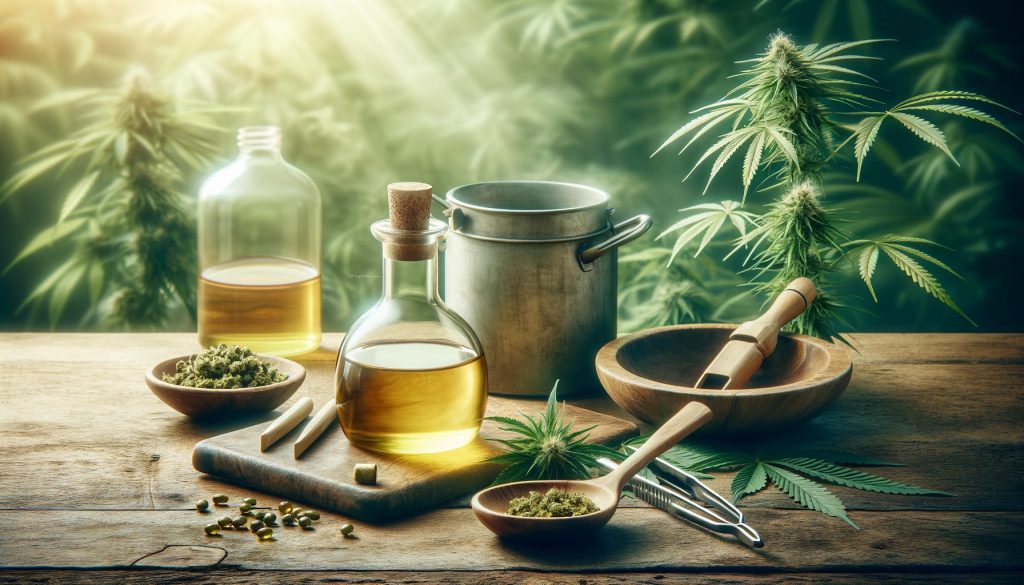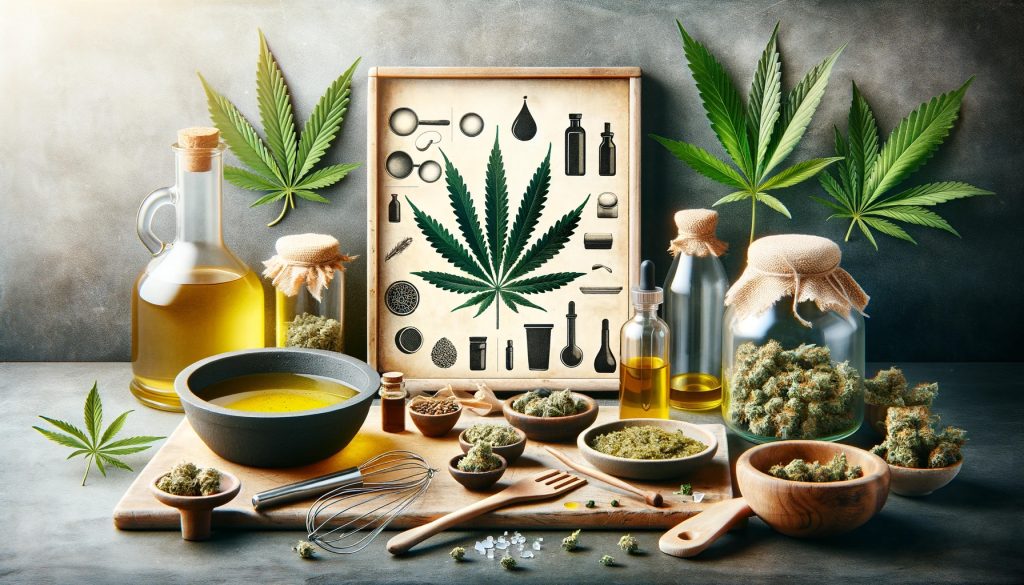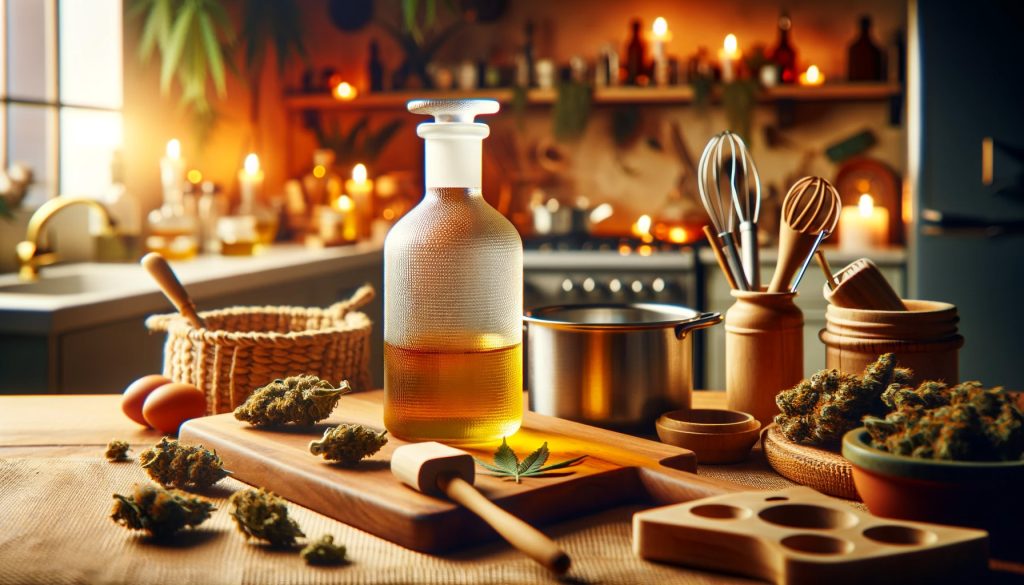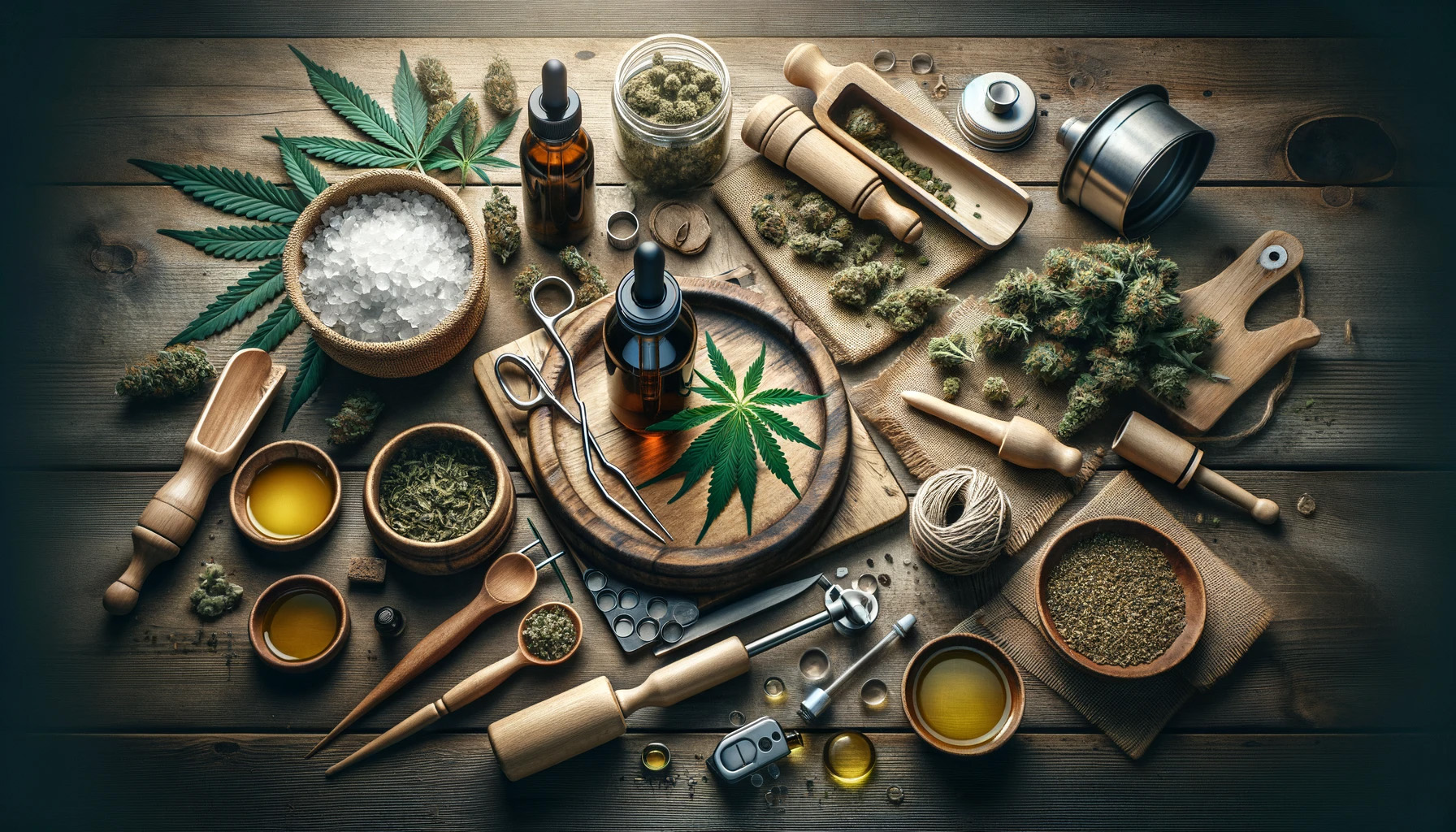If you’re interested in learning how to make homemade cannabis oil, you’ve come to the right place.
THC and CBD are two of the main precious cannabinoids found in the cannabis plant. These compounds offer a wide range of potential therapeutic benefits, and one of the best ways to enjoy these benefits is to make cannabis oil at home. Cannabis-infused oil is easy to make and can be used in many ways.
From helping you choose the right ingredients and equipment to explaining the process in simple steps, this guide makes it easy to make cannabis oil at home.
Learn how you can create cannabis concentrates from scratch and experience their many potential benefits. So, let’s get started! Just follow along and you’ll be creating homemade THC oil before you know it!
Cannabis Oil: The Basics

Cannabis oil, also known as marijuana concentrate or THC-infused oil, is derived by combing the cannabis plant’s buds with a carrier oil such as olive, coconut, or avocado oil.
What Is Cannabis Oil?
THC oil, or tetrahydrocannabinol oil, is a cannabis concentrate extraction made from the cannabis sativa plant. It contains extremely high concentrations of THC and other cannabinoids commonly found in cannabis.
THC oil is often used to make edibles (such as baked treats and gummies), topicals (like lotions and ointments), tinctures for sublingual application, and vapes.
Possession and usage of marijuana-derived products are illegal in many states, so it’s important to look up applicable local laws in your area before attempting to make, buy, or use any form of weed oil.
Uses and Potential Benefits of Cannabis-Infused Oil
THC oil is a cannabis concentrate, commonly used for cooking and baking edibles or making topicals. It can also be taken sublingually for faster effects.
Whether you add it to a topical salve or cannabis edibles, THC oil can provide many of the same benefits as ingesting marijuana in other forms. However, its concentrated manner means that it may provide more intense effects than other methods of consumption do.
A versatile product, weed oil can be incorporated into all kinds of recipes or kept simply as-is. For those looking for relief from pain or inflammation without smoking cannabis flower, topicals made with THC oil offer just that. Oils can be applied directly to the skin, where they infiltrate tissue and potentially deliver pain relief.
Making Cannabis Oil

THC is extremely fat-soluble, meaning it blends well with lipids and oils. To make THC oil at home, you’ll need a suitable carrier oil and your preferred strain of cannabis.
Choosing the Right Carrier Oil
When making THC oil at home, the choice of a carrier oil is an important one. Some of the most popular options include coconut oil, olive oil, avocado oil, and vegetable oil. Each of these options has its unique attributes that make it suitable for creating cannabis oil.
Coconut oil is a solid when stored at room temperature but melts into a liquid with heat, which allows it to infuse easily with cannabis flower. It also helps retain terpenes in the final product, leading to more flavor and medicinal benefits from the infused oil.
Olive oil offers a neutral taste profile that doesn’t overpower other ingredients or flavors that are added to recipes. While it may not offer as much infusion potential as some other types of oils, its smoothness makes it ideal for use in edibles and topicals.
Choosing the Right Strain of Cannabis
When making weed oil at home, choosing the right strain is key to achieving the desired effects. There are three main types of cannabis plants: indica, sativa, and hybrid (cross between the two).
Generally, sativas induce energizing and uplifting effects, whereas indicas create a calming effect. Hybrid strains can offer different combinations of both stimulating or sedating experiences.
When selecting a strain for THC extraction, it’s important to consider its potency and flavor profile as well as your desired effects. For example, Blue Dream is an incredibly popular sativa-dominant hybrid that has notes of berry in its aroma profile and provides an effective high without being overly potent; this makes it great for daytime use and extraction for making THC oil.
Skywalker OG is an indica-dominant hybrid that’s known for having a strong, piney-citrus smell and providing relaxing effects, which can be beneficial for those suffering from chronic pain or anxiety symptoms.
The Importance of Decarbing Cannabis
Before you make cannabis oil, you’ll need decarboxylated cannabis. Raw cannabis contains THCA and CBDA, which differ from THC and CBD. THC and CBD are present in cannabis that’s been heated, and these cannabinoids are what give cannabis its therapeutic properties. The process of activating these cannabinoids through heating is called decarboxylation. After carefully heating the raw cannabis, the THCA and CBDA will convert into THC and CBD. The cannabis will now contain active THC and have psychoactive properties.
Equipment and Materials
Before you begin making homemade cannabis-infused oil, you’ll need a few supplies. For the best results, make sure you have a double boiler, a baking sheet, parchment paper, a thermometer, a cheesecloth, a strainer, a mason jar, and a glass bowl. Have your carrier oil and fresh flower or ground flower of choice handy. Ground cannabis usually works best when making THC oil, so you may want to grind your flower if it’s not already ground.
Cannabis Oil Recipe

Decarboxylation
Begin by decarboxylating the cannabis flower by baking it in the oven to activate the THC and CBD. Preheat your oven to 250 degrees Fahrenheit, line your baking sheet with parchment paper, and place the cannabis on it. It’s important to heat the ground cannabis evenly and maintain a temperature of 250 degrees Fahrenheit for 25 to 30 minutes, stirring occasionally every 10 minutes.
Grinding
Once the cannabis is fully decarbed, let it cool and grind it coarsely before transferring it to a covered mason jar or another airtight container. It should now be light brown or yellow in color.
Cooking
Now we’re ready to combine the ground cannabis with the carrier oil; olive oil and coconut oil are two of the most popular choices. This step can be done using a double boiler or a slow cooker.
Mix 3.5 grams of cannabis flower and ½ cup of olive oil or coconut oil in your double boiler or slow-cooking appliance. (You can use a little more oil if you want your cannabis oil to be less potent.) If you’re using a double boiler, heat the mixture on low heat for several hours (about 6 to 8), stirring occasionally; if you’re using a slow-cooking appliance, heat the mixture on low for several hours (4 to 6), stirring occasionally.
Alternatively, you can complete this step on your stovetop by combining the ingredients in a saucepan and letting the oil simmer on low heat for about 3 hours. This method is fastest, however, you’ll need to stir regularly to prevent scorching.
Regardless of which method you choose, use your thermometer to make sure the temperature of your cannabis-infused oil doesn’t exceed 245 degrees Fahrenheit at any point.
Straining
In the next and final step, we’re going to separate the oil from the cannabis plant material. Line a strainer with a cheesecloth and place the lined strainer over a glass bowl, Carefully pour the mixture through the strainer, allowing the oil to gather in the bowl. Then, lift the cheesecloth and gently squeeze it, letting the excess oil drip into the bowl.
That’s it! You’ve now made your own cannabis oil! Read on for tips and ideas on how to make, store, and use your homemade cannabis oil!
Tips and Tricks for Making Your Own Cannabis Oil

To ensure optimal potency in your homemade THC oil, heat your oil blend at an ideal temperature of 245 degrees Fahrenheit using a double boiler, slow-cooking appliance, or saucepan. Use decarboxylated cannabis (or decarb your cannabis flower beforehand) and ensure proper storage after cooking. Retaining terpenes can enhance the effects of cannabis oil, so it’s important to properly strain the mixture after heating.
Temperature
For optimal results, it’s essential to properly heat your THC oil. The decarboxylation process activates the THC and other cannabinoids within the cannabis, so it’s important to maintain a low cooking temperature during this step. If overheated, the potency of these compounds can be degraded. During the decarbing process, you’ll want to maintain a temperature of 200 degrees to 250 degrees Fahrenheit; during the heating/cooking process, keep the temperature at a steady 245 degrees Fahrenheit.
Storage
For optimal preservation and longevity of your homemade weed oil, we recommend storing it in a tinted, airtight jar or bottle. To reduce oxidation, the container should be kept away from light and air, as exposure to these elements can break down the active molecules in your cannabis oil. For ease of use, you may want to store the oil in a bottle that has a lid with a built-in dropper, as this will make it easier to measure out and administer the oil.
Retaining Terpenes
Retaining terpenes is an important part of making and using THC oil. Terpenes are the compounds that give cannabis its unique aroma, flavor, and effects. When making cannabis extractions like THC oil at home, it can be easy to lose valuable terpenes due to high temperatures or long extraction times. Maintaining the recommended temperatures and adhering to the recommended cooking times throughout the process will help you preserve these flavorful and aromatic compounds, resulting in potent and effective cannabis oil.
Straining Techniques
Straining is an essential part of making a THC oil solution, as it ensures any impurities and plant material are removed before the oil is used for cooking, baking, topicals, etc. There are several different ways to strain your oil.
Cheesecloth
This traditional method involves lining a strainer with multiple layers of cheesecloth and pouring the hot cannabis-infused oil over it so that the cloth catches any large pieces of plant matter.
Coffee Filter
A coffee filter provides an easy way to separate small particles from larger chunks when straining cannabis extractions. To use this method, line a funnel with a paper coffee filter and slowly pour the mixture through so that all unpurified particles remain in the filter.
Fine Mesh Strainer
Another way to strain homemade THC oil is by using a fine mesh metal sieve or strainer. Place it over an appropriate container and pour in the extracted liquid until only sediment remains on the surface of the sieve. Discard what’s left on top.
FAQ
What is cannabis oil?
Cannabis oil is an extract made from cannabis plants. It typically has a high concentration of THC—the main psychoactive compound found in cannabis.
Is making cannabis oil legal?
The legality of cannabis-derived products varies depending on where you live. THC is federally illegal, however, it’s legal in some states. Production and possession of cannabis oil may be illegal in some jurisdictions, so it’s essential to check your local laws before attempting to make or use products containing THC.
What materials and ingredients are needed for making homemade cannabis oil?
You’ll need quality decarbed cannabis material and a base oil or carrier oil—such as olive, avocado, or coconut oil. You’ll also need some equipment including a double boiler, an accurate thermometer to monitor oil temperature, a scale for measuring ingredients, a strainer, a cheesecloth, and an airtight container for storage. If you’ll be decarbing the cannabis yourself, you’ll also need a baking sheet lined with parchment paper.
What’s the difference between hemp seed oil and CBD oil?
CBD oil is made from the leaves, flowers, stems, and stalks of hemp or cannabis plants, whereas hemp oil is made from hemp plant seeds. Pure CBD oil doesn’t contain THC, however, some products may contain a blend of THC and CBD. Hemp oil contains CBD and may also contain trace amounts of THC.
What’s the shelf life of homemade cannabis oil?
The shelf life of THC oil depends on several factors including ingredients and storage containers and conditions. If stored properly in an airtight container and kept in a cool, dark place, cannabis oil can last from 12 to 18 months, longer if refrigerated. Cannabis coconut oil typically lasts a minimum of 18 years and can last for several years with proper storage.
How do I store finished cannabis oil?
For optimal results, it’s important to make sure your cannabis oil is stored properly. It should be kept in an airtight glass jar or glass container and stored in a cool, dark place away from light, humidity, and air, as these factors can significantly decrease the shelf life of your oil.
What can I use cannabis oil for?
Hemp oil has a wide range of potential health benefits and can be used in many ways. Given its anti-inflammatory properties, you could add THC oil directly to topical salves, lotions, and ointments for pain relief. You can add a few drops to baked goods and cooking oil to make your own homemade edibles. You can even consume cannabis oil directly or add it to your favorite meal, snack, or beverage to enjoy the added health benefits of THC and CBD.
Are canna oil and CBD oil the same thing?
No, there are notable differences between canna oil and CBD oil. Canna oil is cannabis cooking oil. It’s typically vegan-friendly and gluten-free and can be made at home or purchased from retailers. Making cannabis cooking oil is fairly simple and the oil mixture can be added to your favorite foods and baked goods, allowing you to create your own homemade cannabis edibles. Canna oil has a high concentration of THC and produces psychoactive effects, whereas CBD oil either contains no THC or trace amounts of THC. CBD oil doesn’t contain enough THC to have psychoactive properties.
Conclusion
Whether you add it to baked treats to make homemade edibles or use it to make your own topical salve, making canna oil at home is a fun and easy way to enjoy the many benefits of THC.
Making your own custom oils can provide many benefits, as you have full control over potency, dosage, and strain selection. When making your own oil, it’s essential to understand the decarboxylation and cooking processes to properly convert and extract the cannabinoids from the plant into the oil. With just some decarbed cannabis, some basic equipment and ingredients, and a little patience, you easily make your own canna oil. We hope you find this article helpful and informative, and we hope it inspires you to make cannabis oil at home!






